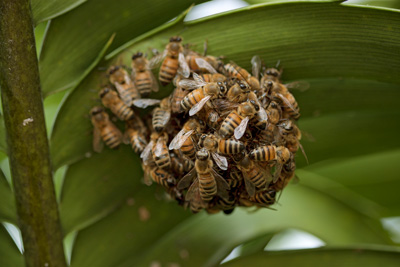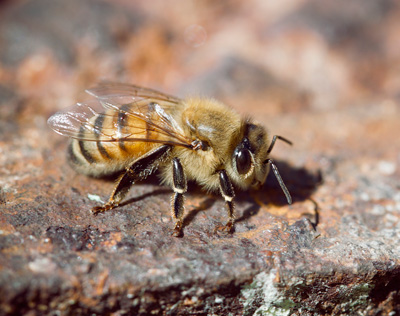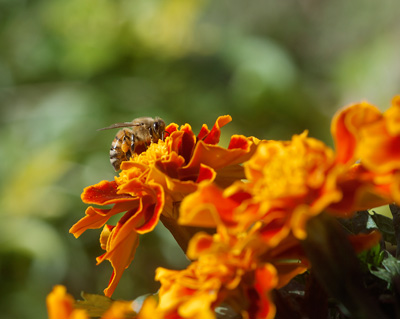Bee populations are declining precipitously. Sadly, that’s no longer news.
Beginning in fall 2006, beekeepers reported fatalities of 30 to 90 percent of their hives, U.S. Department of Agriculture records show. This phenomenon became known as Colony Collapse Disorder, which affects worker bees directly, and consequently entire colonies.
No single cause of Colony Collapse Disorder has been found; it is often considered the result of a combination of problems.

Bees rely on flowering plants for pollen and nectar. Kenneth Setzer/FTBG.
Before the 1600s, North America had no honeybees. Honeybees, like the Europeans who introduced them, were immigrants from the Old World. But there was no lack of bees here. We had bumblebees, sweat bees (often confused with flies), digger bees, mason bees, carpenter bees and leaf-cutter bees — and still do.
If these other types of bee are new to you, don’t feel ignorant — there are an estimated 20,000 species of bees worldwide. That’s a huge number, even in the insect world.
Besides their intrinsic beauty and intricate, complex lifestyles, bees are of great value to life on Earth, particularly to humans. There are animals that eat bees, live on, in or with bees. Burrowing bees even recycle our soil nutrients. I bet a hefty book could be written on the plants and animals that depend on bees.

Bee congregations may be attacking an enemy or fleeing from a destroyed hive. Kenneth Setzer/FTBG.
But if you want a price tag to convince you of their value to us, the USDA Agricultural Research Service reports that bee pollination adds about $15 billion to crop value annually. That’s not including the value of the crops themselves, which is much higher.
But it is much more complicated than money. Cost aside, how could we possibly manage to pollinate hundreds of millions of plants ourselves? If you think food is costly now, imagine having to pay for even more human involvement in the process.
Some of the contributing factors for CCD include Varroa mites, which transfer viruses to both wild and kept bees; and the fungus Nosema apis, which is a parasite to honeybees. Extended cold, which forces bees to remain confined together in their hives, seems to increase infection rates of Nosema. There’s even a mite that infests honeybees from within their trachea, feeding on their bug blood, called hemolymph. Scientists are developing ways to mitigate all these plagues, but with mixed results.
So what can we do? The one contributing factor of Colony Collapse Disorder we can more easily control is pesticides — in particular, crop pesticides in the class of neonicotinoids. There are differing opinions on the actual damage done by neonicotinoids, of course, but it’s important to note who’s funding the various studies.

A honey bee — it's really cute up close. Kenneth Setzer/FTBG.
Don’t indiscriminately spray bug killers, especially outdoors. Often the residual chemicals left behind will not harm your target (like a lubber grasshopper) but will kill a honeybee. If you must spray, avoid doing so at midday, when bees are out foraging for pollen and nectar.
Also avoid herbicides, particularly those containing atrazine, which was banned throughout Europe because it contaminated groundwater. It also wreaks havoc on susceptible amphibians, causing all kinds of hormonal and reproductive destruction. Their permeable skin makes them extra vulnerable to pollutants; but skin aside, are we really so different from amphibians? Pick the weeds by hand (then compost them), and we will all be healthier.
Supplementing their food supply is an effective way to aid the bees. In times of stress, finding a supply of pollen and nectar is literally a lifesaver. Native flowering plants, as usual, are your best bet. Those weedy-looking beggar’s needles are a favorite of bees and butterflies; so are many other wildflowers. Bees also love coconut palm flowers, so avoid cutting them off prematurely.
A nice strategy is to offer plants that flower at different times of the year to provide a steady food supply. Strive for diversity and for plants that produce a lot when they do flower, like lantana and firebush. My native wild coffee bush serves as the local bee meeting place when it flowers. Even planting food for yourself, like plants in the cucumber family, will produce flowers attractive to bees.

This honeybee is carrying pollen on its hind leg in a pocket called the corbicula. Kenneth Setzer/FTBG.
Honeybees aren’t the only beleaguered workers. Another important pollinator is the bumblebee, known to pollinate blueberry, tomato, eggplant and peppers among others. Leafcutter and other bees are pollinators also.
You can assist them in similar ways to the honeybee, but also by providing areas of bare sandy soil for their subterranean dwellings. Some solitary bees will live in cavities you can create by drilling holes in a block of wood and hanging it in a tree, or try tying a clump of bamboo stems together for the same result.
Remember, there’s no need to fear bees. They really do not want to sting you. Stinging doesn’t benefit them, and often means the end of their life. Keep some flowers growing to feed them, and they’ll feed us all amply in return.
